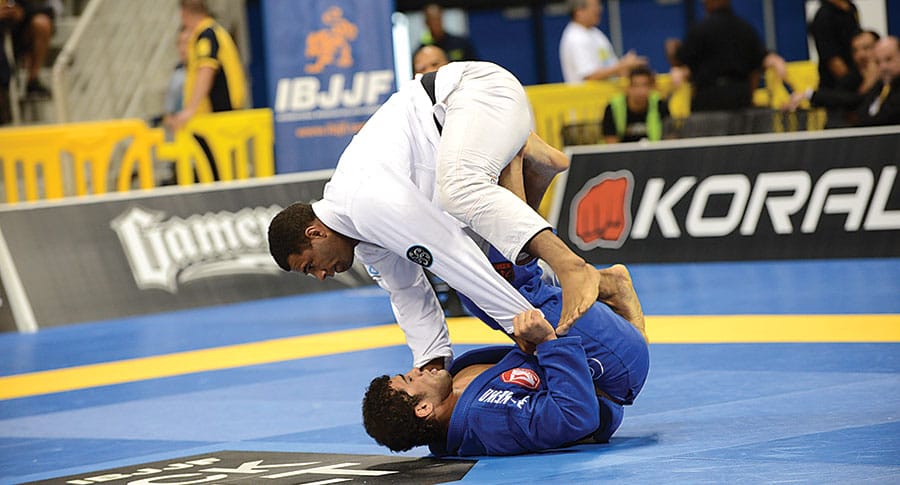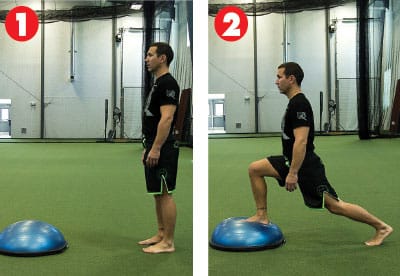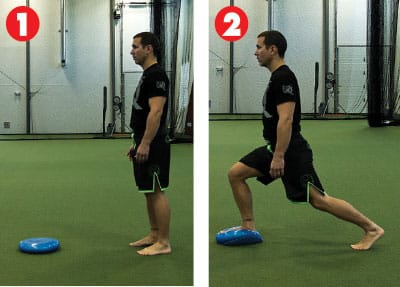Improving Your Balance

So grappler, you say you want to improve your balance? Maybe the first thing we better do is define what we mean when talking about balance. It turns out that it’s a little more complicated than you may think, especially when we talk about applying it to jiu-jitsu.
Balance in jiu-jitsu is the ability to resist falling down, being pushed over, or being swept against your will. This could be on your feet, in the guard, or in any other position on the mat. Balance can be a conscious ability, like when you realize someone is starting a sweep so you adjust your base. It can also happen unconsciously, for instance when you are standing and grip fighting and you resist being pushed over without really thinking about it.

The Three Systems
Your body has to carefully coordinate input from three different systems in order to maintain balance.
The vestibular system regulates equilibrium and provides information on position changes and acceleration. All mammals use this system of sense organs located in the inner ear.
The somatosensory system uses the sense of proprioception and other somatic information from specialized neurons located throughout the body to determine how your body is positioned in space, relative to itself. For instance, with your eyes closed you can move your arm straight out and then bend it to 45°. You are using feedback from the somatosensory system and your sense of proprioception to know how your arm is positioned.
The visual system gives you information about your position in relation to other objects, as well as head orientation and movement.
To achieve balance you need good input from at least two of these three systems.
Balance Diagnostic

If you want a simple test to check your balance, grab one of your training partners and do this.
Stand heel to toe, arms crossed over your chest, and close your eyes. Remain standing for 60 seconds. Your partner should watch for body sway and film you so you can see the results for yourself.
If you remain upright and don’t sway too much, congratulations! You’ve got decent balance. If you fall down or wobble around like a drunken Karate Kid, we’ve got some work to do!
Why we fall down
We fall down when our center of mass extends beyond our base gravity (which used to be pulling us down into that base), and pulls us down outside of that base. The further from our base we extend, the bigger the force. At some point we are no longer strong enough to overcome the force and we fall over.
That means we have two ways to improve our balance. We can avoid extending our center of mass beyond our base, also known as postural control. We can also improve our strength and ability to counteract the force of gravity. We’ll take a look at some ways to improve our ability in both areas next.

Improving Postural Control
This is the kind of balance control you are probably already familiar with. Standing on one leg, sitting on a stability ball, doing a handstand, all require good postural control. The exercises listed below can be used in a series of progressions, adding more difficulty as you master each step. Take your time and don’t rush, your body will need time to learn each variation and your balance will slowly improve as you go along. All of these exercises can be performed on the floor or on progressively more unstable surfaces as you go along.
The Exercises
Step Ups Progressions
Using a box, stairs, or an unstable surface, such as a stability disk or bosu ball, step up onto one leg and lift the other knee to 90° in front of your body. Hold steady for 10 seconds. Step back down and switch to other leg. Repeat 10x.

Lunge Progressions
Forward lunge is a good strength building exercise, but it is also fantastic for improving balance. Especially when you put your forward foot on an unstable surface. Start standing, step forward onto the floor or unstable surface. Your body should be approximately half way between your front and back foot. Keep your core tight and back straight. Hold for 30 seconds, repeat 10x.


Jump to Single Leg
This exercise introduces a high dynamic force to the balance equation by starting with a jump. Because you are moving forward and down you’ll need to control the deceleration with a single leg, which places a huge workload on all the stabilizing muscles. Start by trying this on the floor, and only when comfortable, move to an unstable surface like a foam pad. The further and the higher the jump, the more difficult controlling the landing will be. Jump from both feet, landing on one leg and holding your balance for 5 seconds. Switch to other leg. Repeat 10x.

Balance Bonus Tip
Another way to improve balance and overall kinesthetic awareness is to follow some advice from Bruce Lee, and “Be like water my friend.” Make a conscious effort to relax muscles that don’t need to be tense. Whether on the mat trying to execute a collar choke, or just standing on the sidewalk waiting for the bus, when you have excess tension in your body it impairs your balance and movement by causing a cascade of muscular contractions and reactions. While your muscles are fighting each other just to try and stay balanced, they can’t be used for other movements. This slows you down and tires you out. Use only the muscle tension you need to get the job done and learn to rely on your skeletal structure to hold you up.

Knowing where your opponent is without the use of your eyes is a pretty cool and useful trick.
Make it a point to occasionally roll with your eyes closed. Remember that the body needs input from at least two of the three systems that help control balance. When you block the visual system it sharpens your awareness of the queues from your vestibular and somatosensory systems. Not only will this improve your balance, but it will also develop your sensitivity. Eventually, you will literally be able to feel your opponent prepare to move. Balance combined with sensitivity make timing possible, and will improve your game dramatically. A basic game with good balance, sensitivity, and timing can defeat stronger or more technically skilled opponents in many cases.
Medicine Ball Hip Abduction
Stand on a medicine ball or other unstable surface and slowly move your leg out to the side, away from your body. Go as far as you can while still maintaining your balance on the ball. Hold 5 seconds and come back to standing. Switch to other leg. Repeat 10x.

Pistol Squats
If you can lunge with no problem on an unstable surface maybe you’re ready to challenge yourself with the pistol squat. Start with feet together and arms at your side. Slowly straighten one leg and both arms in front of you while lowering your hips to the ground. Hold for 5 seconds and come back to standing.

If you want to kick it up another notch perform on top of a kettlebell or ball. With the kettle bell be careful not to tweek your ankle.

Stability Ball
An article on balance and jiu-jitsu really wouldn’t be complete without at least a couple exercises on the stability ball. Who hasn’t watched Jeff Glover or Ryron Gracie playing around on one of these things on YouTube? A quick word of caution, the stability ball has been responsible for more injuries in my club than grappling. Go slow and use a little common sense with this one.
Start with the ball under one knee and both hands stabilizing it. Slowly work both your knees up onto the ball. Once you are in position and feel stable, sit up tall and put both hands on hips. Try to hold this for 30 seconds.
After you have the kneel-up mastered, move from kneeling to combat base. Again, go slowly and once you are in position, sit up tall and hold for 30 seconds.
The final step is standing on top of the stability ball. It’s a good idea to learn this with an assist, such as a pull up bar. Another bonus, I promise you’ll get a chance to practice your roll outs when you hit the mats after wiping out.


Strengthen the Core
All of the above exercises provide some strength improvements in the legs, the stabilizer muscles, and in the core. But because the core is really where balance starts, it never hurts to make it stronger. The stronger your core, the easier it will be for you to correct from mistakes and bad leverage situations that would finish off a soft bellied opponent. If you’re looking for new ways to work the core you’re in luck, a future article will focus on just that.
